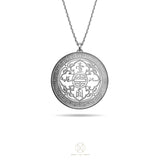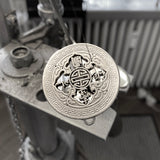Trade Dollar Great Britain / also called Hong Kong Dollar
With the extension of British trading interests in the East, especially after the founding of Singapore in 1819 and Hong Kong in 1842, it became necessary to produce a special dollar so as to remove the reliance of a British Colony upon the various foreign coins then in circulation.
"China trade silver dollars were a direct result of the First (1839-1842) and Second Opium War (1856-1860), which broke out when Chinese authorities tried to stop Britain from smuggling opium into the country. The loser, China, had to open up a number of ports to British trade and residence, and cede Hong Kong to Britan. In the decades that followed, merchants and adventurers flocked to these areas, and international trade flourished. Foreign banks were established and large silver coins from all over the world began arriving to pay for tea, silk and Chinese porcelain to be shipped abroad. These .900 fine silver trade dollars were then circulated throughout China, where they were readily accepted as a medium of exchange. The British Trade Dollars, minted exclusively for use in the Far East, depict Britannia standing on shore, holding a trident in one hand and balancing a British shield in the other, with a merchant ship under full sail in the background. On the reverse is an arabesque design with the Chinese symbol for longevity in the center, and the denomination in two languages - Chinese and Jawi Malay.
The British Trade Dollar was designed by George William De Saulles and minted from 1895 for Hong Kong and the Straits Settlements. But after the Straits dollar was introduced to the Straits Settlements in 1903, it became exclusively a Hong Kong coin produced until 1935; those with the mint mark "B" were produced at the Bombay Mint; others, marked "C", were struck in Calcutta. Those with no mint mark were produced in London. The mint mark "C" can be found in the ground between the left foot of Britannia and the base of the shield, while the mint mark "B" is located in the center prong of the trident. The 1921-B dollar was struck but never released for circulation, and only a limited number of 1934-B and 1935-B coins were released.
In some cases, the date on an already manufactured coin die was aged. As this could not be done without leaving a trace of the former date, some coins show traces of an older date below the clearly visible date. These include 1897-B over 1896-B, 1900-B over 1894-B, 1901-B over 1900-B, 1909-B over 1908-B, 1904-B over 1898-B, 1903-B over 1902-B, 1908-B over 1903-B, 1904-B over 1903-B, 1929-B over 1901-B, 1908-B over 1907-B, and 1910-B over 1900-B.
The British Trade Dollar was demonetized on August 1 , 1937.












